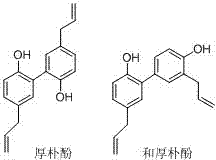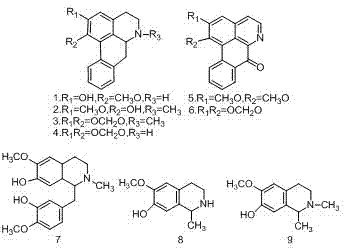Process for preparing magnolia officinalis total phenol extract by adsorptive separation
A technology of adsorption separation and preparation process, applied in the direction of medical preparations containing active ingredients, plant/algae/fungus/moss components, plant raw materials, etc., can solve the problems of large solvent loss, small preparation amount, cumbersome process, etc., and achieve The effect of low production cost, easy operation and simple process
- Summary
- Abstract
- Description
- Claims
- Application Information
AI Technical Summary
Problems solved by technology
Method used
Image
Examples
Embodiment 1
[0021] A process for extracting high-purity total magnolol with commercialized AB-8 macroporous adsorption resin, the steps are as follows:
[0022] 1) Weigh 23g of Chinese herb Magnolia officinalis, crush it, extract it with 90mL of 5% (v%) hydrochloric acid ethanol solution at 60°C, reflux for 2 hours, filter with suction, extract twice, combine the filtrate to recover ethanol by vacuum distillation, and add Water with pH=2, centrifuged to collect the precipitate. Dissolve the precipitated solid in 140 mL of 30% ethanol aqueous solution with pH = 12.5, and centrifuge to remove a small amount of insoluble matter to obtain an adsorption liquid.
[0023] 2) Pass 60mL (2BV) of the above adsorption solution through a resin column equipped with AB-8 macroporous adsorption resin (the inner diameter of the column is 8 mm, the column length is 250 mm, and 30 mL of wet resin is installed), and the adsorption rate is 1.0 BV / h ;
[0024] 3) After the adsorption is completed, clean the...
Embodiment 2
[0029] The process for extracting high-purity total magnolol with commercialized D101 macroporous adsorption resin, the steps are as follows:
[0030] 1) Weigh 25g of Chinese herb Magnolia officinalis, crush it, extract it with 90mL of 4% (v%) hydrochloric acid ethanol solution at 55°C, reflux for 2 hours, filter with suction, extract twice, combine the filtrate to recover ethanol by vacuum distillation, and add Water with pH=2.5, centrifuged to collect the precipitate. Dissolve the precipitated solid in 145 mL of 30% ethanol aqueous solution with pH = 11.5, and centrifuge to remove a small amount of insoluble matter to obtain an adsorption liquid.
[0031] 2) Pass 90mL (3BV) of the above adsorption solution through a resin column equipped with D101 macroporous adsorption resin (the inner diameter of the column is 8mm, the column length is 250mm, and 30 mL of wet resin is installed), and the adsorption rate is 0.5 BV / h;
[0032] 3) After the adsorption is completed, clean the...
Embodiment 3
[0037] The process for extracting high-purity total magnolol with commercialized CAD-40 macroporous adsorption resin, the steps are as follows:
[0038] 1) Weigh 26g of Chinese herb Magnolia officinalis, crush it, extract it with 85mL of 6% (v%) hydrochloric acid ethanol solution at 62°C, reflux for 2.5h, filter with suction, extract twice, combine the filtrate to recover ethanol by vacuum distillation, and replenish Add water with pH=2, centrifuge to collect the precipitate. The precipitated solid was dissolved in 140 mL of 30% ethanol aqueous solution with pH=12, and the insoluble matter was removed by centrifugation to obtain an adsorption liquid.
[0039] 2) Pass 90mL (3BV) of the above adsorption solution through a resin column equipped with CAD-40 macroporous adsorption resin (the inner diameter of the column is 8 mm, the column length is 250 mm, and 30 mL of wet resin is installed), and the adsorption rate is 1 BV / h ;
[0040] 3) After the adsorption is completed, cle...
PUM
 Login to View More
Login to View More Abstract
Description
Claims
Application Information
 Login to View More
Login to View More - R&D
- Intellectual Property
- Life Sciences
- Materials
- Tech Scout
- Unparalleled Data Quality
- Higher Quality Content
- 60% Fewer Hallucinations
Browse by: Latest US Patents, China's latest patents, Technical Efficacy Thesaurus, Application Domain, Technology Topic, Popular Technical Reports.
© 2025 PatSnap. All rights reserved.Legal|Privacy policy|Modern Slavery Act Transparency Statement|Sitemap|About US| Contact US: help@patsnap.com


